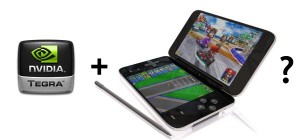Rumor: Next Generation DS to use NVidia Tegra Graphics Chip?
This is some pretty big news…if true. Rumor has it that Nintendo is hard at work on the next-generation DS system, and that it will be unveiled late 2010 and include Nvidia’s latest Tegra graphics chip. This is all rumor at this point, so don’t get your hopes up. But it is interesting to see what all the next DS has once it’s unveiled! Read on below for the rest of the details:
When Jen-Hsun Huang, co-founder and CEO of nVidia announced that he expects to see Tegra capturing 50% of nVidia’s revenue within the next couple of years, a lot of people thought that this is a smoke screen to sway the attention from its battles against AMD and Intel.
Incredibly how it may sound, from what we are hearing nVidia is dead on achieving its course. With a very aggressive approach, the company managed to sway not just Microsoft with the Zune HD multimedia player [based on Tegra APX 2600], but also a long-time IBM and ATI customer – Nintendo.
Launched in 2004, the Nintendo DS and its two latter redesigns [DS Lite and DSi] sold in massive 111.49 million units. With almost 40 million handheld consoles sold in United States alone, Nintendo DS owns 68.3% of worldwide market share.
As the time passed by, Nintendo started to work on the successor of its handheld console with a debut planned for late 2010 [Tokyo Game Show?]. According to our confidential sources, Nintendo is going to use Tegra System-on-Chip processor for the successor of DS/DSi handheld console. Unlike the current design, nVidia offered a single-chip proposal to Nintendo, a company famous for keeping the hardware platform absolutely simple.
Given the fact that Nintendo DS hardware is based upon 16-bit and 32-bit ARM cores, it looks like Next-Gen DS could be backwards compatible with the DS application library. According to our sources, all of the apps that came for old DS could run on a single ARM11 core, yet alone the next-gen CorTex-A9-based Tegra, leaving graphics subsystem to do “something smarter”.
Currently, we have no information what exact chip is being used [just that nVidia won the contract], but with the debut set for February 2010, the second generation of Tegra chips could make an excellent base [to be launched at Mobile World Congress in Barcelona].
The question of power consumption and performance is quite aninteresting one. With Gen2 Tegra offering quite a graphics punch;GeForce 9 based hardware [CUDA-enabled design] should offer immenseexperience on small screens – we see no reason why you could not have4x Anti-Aliasing and 8x Anisotropic filtering on a dual-screen system.If Nintendo picked the current gen hardware, i.e. Tegra 600 or APX 2600- it will be getting 65nm chips. If they go with 2nd gen parts, theywill get 40nm chips offering higher performance and lower powerconsumption. The moment we learn about the exact hardware going intoNintendo’s next-gen console, we’ll inform you.Thus, it is not hard for us to imagine that Tegra could outship GeForce boards just like Intel’s Atom CPU shipped in more units than expensive Nehalem processors. Naturally, the profit ratio is significantly different, but something in the range of $4-5 per chip would mean nVidia could earn half a billion USD from a single deal [over the course of life for the Nintendo’s next-gen part].
Now, the billion dollar question is: if Nintendo chose nVidia for the handheld console, does that mean nVidia may have an entrance into the lucrative Wii business? Bear in mind that Wii console was sold in 53.97 million units, taking almost half of current console market [48.4%, according to ********.com]. Also, we wonder what is going to be in next-generation PlayStation Portable…


